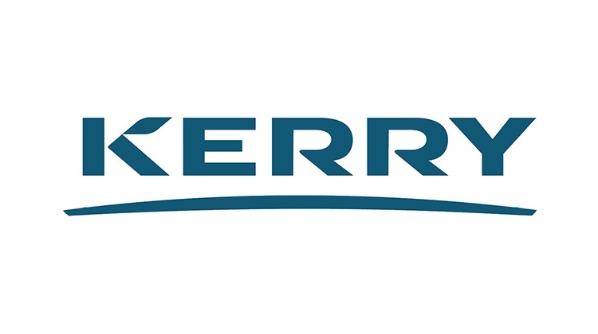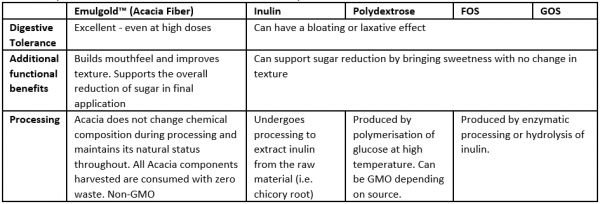Promotional Features
Acacia fiber’s turn in the spotlight: Boosting soluble dietary fiber, naturally and sustainably
Following decades of targeted messaging, most people appear to understand the importance of consuming enough fiber in their daily diets.
In fact, according to a Kerry study, 61% of consumers believe eating more fiber is the best way to manage digestive health.1 In addition, a recent study found that participants who consumed the most fiber had approximately a 20% lower risk of developing dementia later in life.2 Moreover, 80% of consumers in the UK, France and Spain agree that fiber is important for achieving immune health3, with one-third of European consumers saying they aim to increase their fiber consumption.4
Despite this strong supporting evidence, an estimated 600 million people in Europe, and many more worldwide, still do not get enough fiber in their daily diets. Throughout the continent, one in five adults is affected by constipation5, and only 9% of adults in the UK consume the recommended amount of fiber. In 2015, the UK government increased the dietary recommendation from 24g of fiber per day to 30g, but since then there has been very little improvement in the UK population’s intake. The European Food Safety Agency recommends 25g per day, but the average European intake is just 17g. Less than 20% of Europeans consume the RDI for fiber, and less than 10% in the UK reach this level.
There is solid evidence for continuing to push for public engagement around this issue. For one, raising individual daily consumption of fiber to the recommended level would lead to a substantial reduction in fiber deficiency-related health issues, saving literally hundreds of millions of euros in healthcare costs each year.6 Simply reformulating existing products by fortifying with fiber would allow many more consumers to get the recommended daily allowance, helping to lower the risk of heart disease and diabetes in a majority of adults. In short, the direct society-wide and personal benefits of raising daily fiber intake levels are compelling.
Acacia soluble fiber (Gum Arabic) solves the fiber challenge in foods and beverages
The challenge for food and beverage manufacturers is that fiber-rich or -fortified foods and beverages are often just not as tasty as traditional products that have had the fiber processed out of them. White bread is a perfect example: Despite its low fiber content, consumers’ widespread love of white bread allows it to maintain its standing as the most popular bread choice all over the world, with the highest percentage of sales as firm proof. Part of its rich appeal is cultural tradition, but another aspect is that lower-fiber foods often simply taste good. This makes such habits difficult to change.
One way forward is to fortify white bread and other such low-fiber products during the manufacturing process to take the fiber decision out of the end consumer’s hands. This would deliver a fiber boost to the public while still providing the taste, look and quality consumers have come to expect from their white bread and other popular items.
One problem to contend with, however, is that fiber fortification can often significantly change the sensory properties of bread. This can include increased “stickiness” of the dough during processing, dough dryness, a decrease in bread volume, and increased crumb cohesiveness and firmness, all of which affect final product quality. Some fibers also cause digestive upset, bloating and bitter off-notes; these are things consumers won’t fail to notice. Fortunately, these and other challenges can be addressed by using natural fiber sourced from a sustainable source: the humble Acacia tree.
Acacia: Helping to create resilience in our global food supply chain
An excellent source of soluble dietary fiber, acacia fiber is produced using the natural resin of the acacia tree that grows in the Sahel region of Africa. Local farmers harvest the gum by hand every season in a sustainable manner that does not damage tree formation. Acacia harvesting is often a form of secondary income for local farmers at a time when other sources of agricultural earnings are at their lowest levels, providing critical revenue for vulnerable communities.
Why does this matter? Well, consumers are showing increasingly that they care about the provenance of ingredients and their impacts on sustainability. Acacia fiber fulfils consumer calls for sustainable, naturally derived/clean-label ingredients that support farmers and grower communities.
Also important, acacia trees benefit the environment by combating “desertification” through their role as a nitrogen-fixing legume species that helps in balancing soil nutrients and enhancing soil fertility. Soil and land degradation is a key contributor to climate change and food insecurity. Acacia trees help combat this and improve water filtration and reduce evaporation by reducing wind speed, leading to more efficient use of both water and fertilizer. Additionally, and even more in their favour, acacia plantings benefit other agricultural crops, such as sorghum and maize; when planted together, this results in increased food yields.
Why choose Acacia Fiber over other fibers?
Studies confirm that Kerry’s Emulgold™ fibre (acacia fibre) delivers valuable satiety benefits and a prebiotic effect by promoting the growth of healthy bifidobacterial and lactobacilli bacteria in the digestive system
According to Innova, 23% of consumers globally try to balance their weight through a nutritionally balanced approach. Consumers will be interested to learn that clinical studies have shown Kerry’s Emulgold™ fiber to have a meaningful effect on satiety, leading to reduced feelings of hunger: In the study, just a 5g serving gave subjects a significant satiety effect and significantly lowered their energy intake at the first meal three hours after ingestion. Further, it staved off feelings of hunger for at least three hours after consumption, with no compensation effect.7 Emulgold™ also promotes the growth of healthy bifidobacterial and lactobacilli bacteria in the digestive system, a beneficial prebiotic effect that is superior to chicory root (inulin) at similar levels.8
High in fiber white bread
Repeated application trials have shown that Emulgold™ maintains taste, texture and mouthfeel while fortifying white bread with up to 6g of fiber per 100g, far above the 1.6g normally found in white bread. This marked increase — an exceptional 275% improvement — allows for a “high in fiber” claim and brings the final white-bread product equal to its whole wheat counterpart. Probably most important is the fact that Emulgold™ doesn’t interfere with the excellent taste and texture consumers have come to expect and demand.
For manufacturers, fortifying bread products with Emulgold™ means capitalising on a few powerful quality attributes over other fiber options. For example, Emulgold™ has minimal or nil impact on dough rheology, and performs favourably in terms of taste, effect on texture, bread volume, softness and resilience over shelf life. Another plus for acacia fiber: It has an excellent level of digestive tolerance even at high daily intake levels over 40g. Further, it conforms to the ISO standard of “natural” for clean labelling, and enjoys more stable pricing than several other sources of fiber. All of these advantages elevate acacia as a choice for use in baked goods.
Beverage fiber fortification
There are important practical considerations to take into account when attempting to fiber-fortify beverages. First of all, the fiber ingredient needs to be easily dispersible. It must be highly stable in low-pH situations, and void of negative influences such as gelling, swelling or thickening. Emulgold™ meets these criteria fully, with the added benefits of improving mouthfeel and delivering enhanced flavour. Also, due to the ability of its polysaccharide structure to improve the mouth coating effect — i.e., which holds sweeteners or flavour modulators in the mouth for a longer period of time and extends the sweetness perception — Emulgold™ has a solid role to play in reduced-sugar beverages. Earlier this year, Innova reported that 28% of consumers made changes to their diet, by simply selecting low sugar products — the number 1 behaviour change reported, above low fat/low salt/high protein. Emulgold™ also has the ability to reduce the glycaemic index (GI) of food products and is suitable for Low-FODMAP and KETO diets. Sports nutrition and meal replacement beverages likewise fare well using Emulgold™ due to its increased satiety attributes.
Nutrition bars, cereals and Emulgold™: A perfect fit
57% of consumers seek digestive health benefits in the cereal and breakfast bar categories, however very often, these products fall into the high fat/sugar/salt category. Emulgold™ can help improve the nutritional profiles of such products for manufacturers looking to optimise their nutri-scores and fortify with fiber. While delivering a high concentration of soluble dietary fiber, Emulgold™ supports the overall reduction of sugar by working as a binder to partially replace sugary syrups. It also helps to prevent dry mouthfeel over shelf life — a common challenge of bars and cereals/granola — by maintaining moisture balance.
As a natural, clean-label, consumer-friendly ingredient with a noteworthy sustainability profile, Emulgold™ has a vital contribution to make in surmounting the challenge of raising daily fiber intake in the world’s population. These perks, along with its ease of application and the nutritional benefits of acacia, can mean better health outcomes without compromising the expectations of consumers or product manufacturers. Most important: Emulgold™ adds fiber without altering taste or texture. This is great news for white bread and the other foods and beverages so loved by consumers worldwide. Tasty, enjoyable and healthier — it’s hard to argue with that.
Click here to get your report on ‘The Rise of Acacia; Market Opportunities and Application Concepts’
References
1. Kerry Global Consumer Survey — Digestive & Immune Health, 2019.
2. https://www.medscape.com/viewarticle/969760
3. Kerry Global Consumer Survey — Digestive & Immune Health, 2019 and 2021.
4. Innova 2020.
5. Kerry Global Consumer Survey — Digestive & Immune Health, 2019.
6. Journal of Pharmacy and Nutrition Science, 2015.
7. Calame et al,2011. Evaluation of satiety enhancement, including compensation, by blends of Gum Arabic. A methodological approach, Appetite, Volume 57, Issue 2.
8. Calame et al, 2008. Gum Arabic establishes prebiotic functionality in healthy human volunteers in a dose-dependent manner. British Journal of Nutrition.



